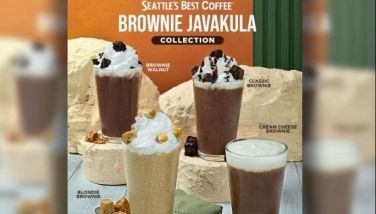Energy Drinks, Anyone?
CEBU, Philippines - Cobra. Sting. Samurai. No, that’s not a list of video games or rock bands, but some of the most popular energy drinks in the market nowadays. Whether to boost energy for sports, or just to get through the day, adults and young professionals alike are now buying these so called energy drinks. The God-given 24 hours now seem insufficient to do all the tasks planned for the day. Man’s sleeping pattern has been slowly varying due to many factors like stress, traffic, different work environment and biological work pattern.
In other countries, it is not odd to see people having two or three jobs in order to make both ends meet. Call it multi-tasking or whatever, but given the chance to earn, any man/woman will just do about anything. The need to extend one’s energy, productivity, alertness and to stay focus on the job paved the way for the popularity of the so-called energy drinks.
In order to stay wide awake and alert on the job, Japan in 1960 released Lipovitan. The energy drink was marketed mostly to blue collar workers. Also in the same year, Gatorade was introduced in the United States in order to improve the performance of its athletes. It was invented for the football team of the University of Florida, the Gators, hence the name Gatorade. The drink was designed primarily to aid rehydration of the Gators and lengthen their performance levels.
In 1985, Jolt Cola was introduced in the United States. Its selling approach centered on the drink’s caffeine content which aim at promoting alertness. Pepsi cola Company also introduced in the market its line of energy drink in 1995 named Josta, but ceased distribution in 1999. In 2001, Coca Cola introduced its own line of energy drink, Powerade.
In the past few years, diverse energy drinks have flooded the Philippine market, of course with their different taglines as a marketing tool. Today, Red Bull dominates the long list of energy drinks in the market with a market share of 47% worldwide. In a recent market research here in the Philippines, Asia Brewery Inc. retained its leadership position within sports and energy drinks in 2011 in off-trade value terms. The company’s off-trade sales totaled Php 7.9 billion, translating into a 51% share.
Energy drinks are attractive to young people. Approximately 65% of energy drink consumers are between the ages 13 and 35 years old. Presently, there are a total of 67 energy drinks registered with the Philippine Food and Drug Administration (FDA). However, the FDA cannot mention the brand names as this might be construed as a form of advertisement or promotion of the product. The complete list of registered energy drinks in the market can only be acquired from the FDA upon request. The FDA also stressed that not all energy drinks sold in the country are tested, authenticated and registered.
The use of energy drinks to stay awake is nothing new. Based on label statement, energy drinks usually contain sugar and lots of caffeine. Its caffeine content should not exceed 200 ppm (parts per million). A typical energy drink contains about 80 milligrams (mg) of caffeine similar to a cup of coffee, while an average soft drink only contains about 18-48 mg of caffeine. However, there are additional additives in energy drinks. Some of the common ingredients found in energy drinks are:
• Caffeine - a bitter, white crystalline xanthine alkaloid that acts as a stimulant drug. Caffeine is found in varying quantities in the seeds, leaves, and fruit of some plants, where it acts as a natural pesticide that paralyzes and kills certain insects feeding on the plants. It is most commonly consumed by humans in infusions extracted from the seed of the coffee plant and the leaves of the tea bush, as well as from various foods and drinks containing products derived from the kola nut. In humans, caffeine acts as a central nervous system stimulant, momentarily warding off drowsiness and restoring alertness.
• Ephedrine- used for temporary relief of shortness of breath, chest tightness, and wheezing due to bronchial asthma. Ephedrine is a decongestant and bronchodilator. It works by stopping the swelling and constricting of blood vessels in the nasal passages and widening the lung airways, allowing you to breathe more easily.
• Taurine- an amino acid that supports neurological development and helps normalize the level of water and mineral salts in the blood. Taurine is also thought to have antioxidant properties. Taurine is found naturally in meat, fish and breast milk, and it’s commonly available as a dietary supplement. Some studies suggest that taurine supplementation may improve athletic performance, which may explain why taurine is used in many energy drinks. Other studies suggest that taurine combined with caffeine improves mental performance.
• Guarana- a woody, climbing plant of the soapberry family (Sapindaceae), native to South America. The seeds are roasted and used to make a stimulant drink popular in South America, which has a bitter, harsh taste and a faint, coffee-like odor. Its caffeine content is about three times greater than an equivalent amount of coffee; the astringent action is caused by tannin.
• B vitamins - a group of water-soluble vitamins that play vital roles in cell metabolism. The B vitamins were once thought to be a lone vitamin, referred to as vitamin B (just like we refer to vitamin C). Later research showed that they are chemically separate vitamins that often coexist in the same foods. In general, supplements containing all eight are referred to as a vitamin B complex.
• Ginseng-an herb known to supplement energy and has some anti-fatigue components, like relieving stress and increasing memory. Ginseng is natural, so having this in your drink certainly will not hurt. A 200 mg a day seems to be a standard dose, but you can safely take up to 2700 mg. Rare side effects such as diarrhea and headache have been reported.
• Ginkgo biloba — has been used medicinally for thousands of years. Today, it is one of the top-selling herbs in the United States. Ginkgo is used for the treatment of several conditions, many of which are under scientific examination. Available proof demonstrates ginkgo’s efficacy in the management of irregular claudication, Alzheimer’s/multi-infarct dementia, and others. There is a promising early evidence favoring the use of ginkgo for memory enhancement in healthy subjects, altitude (mountain) sickness, symptoms of premenstrual syndrome (PMS), age-related eye disorders, and the reduction of chemotherapy-induced end-organ vascular damage.
• L-carnitine - an amino acid (a building block for proteins) that is naturally produced in the body. L-carnitine helps the body create energy. It is important for heart and brain function, muscle movement, and many other body processes. Because of the way it interacts with the body, it may act as a thermogenic and help augment weight loss and endurance during exercise. Rare side effects include nausea, vomiting, abdominal pain and diarrhea.
• Yerba Mate - derived from leaves of a shrub in the Holly family. It is a natural source of caffeine, but some consider that the form of caffeine in Yerba Mate does not create the negative side effects like the caffeine in coffee and guarana.
• Sugars - Glucose is the body’s preferred fuel. It is for this reason that one gets hyper with a lot of sugar. Energy drinks contain an overdose of sugar, which is transformed into energy. However, too much ingestion of sugar may result to diabetes.
• Creatine - a naturally occurring amino acid (protein building block) that’s found in meat and fish, and also made by the human body in the liver, kidneys, and pancreas. It is converted into creatine phosphate or phosphocreatine and stored in the muscles, where it is used for energy. During high-intensity, short-duration exercise, such as lifting weights or sprinting, phosphocreatine is converted into ATP, a major source of energy within the human body.
• Acai (pronounced as ah-sah-ee) Berry from a palm tree in Central and South America. While a traditional food there for centuries, acai has recently become popular in Europe because of its purported health benefits. Acai berries have a number of substances that could, but are not proven to, boost health. For one, acai berries seem to have very high levels of antioxidants - higher than blueberries, strawberries and many other fruits.
Energy drinks have their down side. Extreme consumption can cause anxiety, headache, palpitation, irritability, insomnia and indigestion. Late last year, a 14-year-old girl died after drinking two cans of a popular energy drink in the United States. The said girl suffered a heart attack brought on by “caffeine toxicityâ€.
These unpleasant effects, which are attributable primarily to coffee, are very common in energy drinks because of at least a couple of reasons: unlike hot coffee that is sipped slowly, an energy drink is consumed rather rapidly; and, many ingredients in energy drinks are thought to work synergistically with caffeine, which greatly boost not only the desired but also the adverse effects of the latter.
Another word of care in taking these energy drinks is that it should not be consumed while exercising or engaging in a sport activity because caffeine is a diuretic, meaning it causes one to urinate very often, a form of dehydration. Energy drinks are unlike from and should not be confused with, sports drinks that are devised to keep people hydrated during intense physical action.
Energy drinks are generally safe as long as they are taken in moderation and not mixed with any alcoholic substance. Nowadays, an emerging trend is mixing an energy drink with gin or vodka to make a high-energy cocktail. This is dangerous, since alcohol is a depressant and has a tranquilizing effect on the body. This mixture maybe deadly as energy drinks can mask the influence of alcohol and the drinker may misinterpret their actual level of intoxication.
Studies have shown that alcohol plus energy drinks radically reduces subjective alcohol-related symptoms such as headache, weakness, dry mouth and impairment of motor coordination, which means when alcohol and energy drink combined, one may involuntarily consume very large amounts of alcohol.
Energy drinks are simple beverages that contain some form of vitamins and other chemicals which boosts your energy for very short span. People who drink this say that it’s very effective. But be aware about the effects of the product.
For optimal energy levels throughout the day, what you really need is:
• Enough sleep.
• Quality nutrition. Plenty of natural food, lean protein, fruits, veggies and whole grains for your fiber, vitamins and minerals, and healthy fats from nuts, seeds and fruits. Limit processed foods, sugars and an excess of white breads and grains. The refined carbohydrates in many white breads and grains sometimes produce the same energy ups and downs as sugar.
• Water. Even slight dehydration is a common cause of energy crash.
• Caffeine in low to moderate amounts. Get your caffeine from coffee or tea, which also provide other health benefits in moderation.
So, you see, you don’t need to spend your hard-earned money on glorified cans of sugar and caffeine anymore. (FREEMAN)
- Latest




























